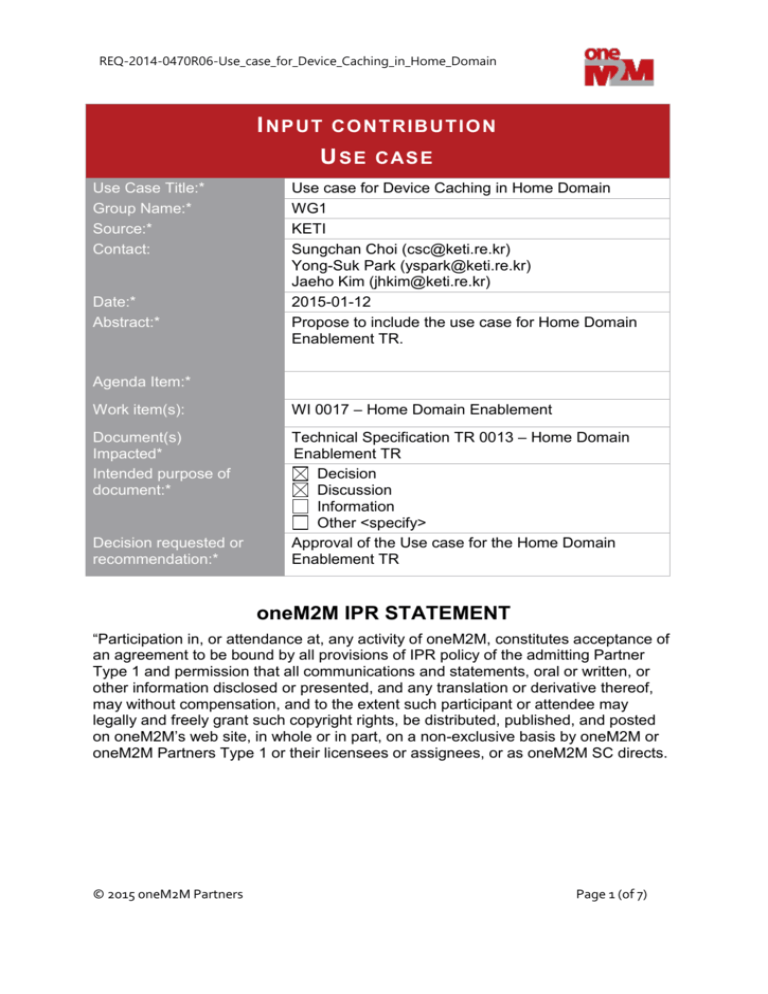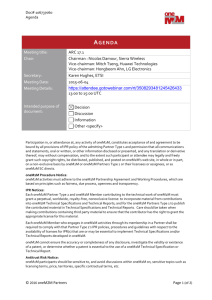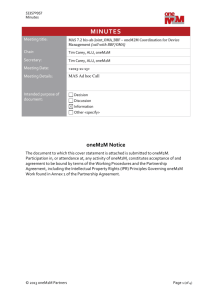REQ-2014-0470R06 - FTP
advertisement

REQ-2014-0470R06-Use_case_for_Device_Caching_in_Home_Domain I NP UT CO N TRI B U TI O N U S E C AS E Use Case Title:* Group Name:* Source:* Contact: Date:* Abstract:* Use case for Device Caching in Home Domain WG1 KETI Sungchan Choi (csc@keti.re.kr) Yong-Suk Park (yspark@keti.re.kr) Jaeho Kim (jhkim@keti.re.kr) 2015-01-12 Propose to include the use case for Home Domain Enablement TR. Agenda Item:* Work item(s): WI 0017 – Home Domain Enablement Document(s) Impacted* Intended purpose of document:* Technical Specification TR 0013 – Home Domain Enablement TR Decision Discussion Information Other <specify> Approval of the Use case for the Home Domain Enablement TR Decision requested or recommendation:* oneM2M IPR STATEMENT “Participation in, or attendance at, any activity of oneM2M, constitutes acceptance of an agreement to be bound by all provisions of IPR policy of the admitting Partner Type 1 and permission that all communications and statements, oral or written, or other information disclosed or presented, and any translation or derivative thereof, may without compensation, and to the extent such participant or attendee may legally and freely grant such copyright rights, be distributed, published, and posted on oneM2M’s web site, in whole or in part, on a non-exclusive basis by oneM2M or oneM2M Partners Type 1 or their licensees or assignees, or as oneM2M SC directs. © 2015 oneM2M Partners Page 1 (of 7) REQ-2014-0470R06-Use_case_for_Device_Caching_in_Home_Domain 6.x Use case for Device Caching in Home Domain 6.x.1 Overview 56.x.1.1 Description In home environments, various home appliances are used. Among the home appliances, some appliances such as fans, heaters, and air conditioners are only used during certain seasons of the year. In oneM2M system, every device registers its information with the oneM2M system in order to receive oneM2M services. Therefore, when a device is powered on, the device needs to check whether it is registered with the oneM2M system or not. For example, consider a scenario where an air conditioner is registered with a home gateway, and the home gateway is registered with a home server in infrastructure domain. Usually, the air conditioner is actively used in summer, rarely used in autumn, and never used in winter. The air conditioner will be inactive in winter. Since the device is not used, it would be beneficial to remove the air conditioner related resources from the home gateway so that it is not discovered or accessed. If the air conditioner is to be used again next summer, the air conditioner needs to register its information with the gateway or server again because the registration information was deleted. However, this will be a reoccurring process of deleting and reinstating the same resources repeatedly over time. Hence, this kind of re-registration process can be an additional overhead to oneM2M system. 65.x.1.2 Source KETI © 2015 oneM2M Partners Page 2 (of 7) REQ-2014-0470R06-Use_case_for_Device_Caching_in_Home_Domain 65.x.1.3 Actors Home appliances are common, general home appliances, such as lighting, refrigerator, washing machine, etc. Specific home appliances are actively used during certain seasons of the year only (e.g. fan, air conditioner, heater, hot-air blower). Home gateway is a device which supports communication technology enabling each home appliance to be connected via Zigbee, Wifi, Bluetooth, etc. and each home appliance can register its information with the home gateway. Home server is a oneM2M platform provided by a service provider in the infrastructure domain. The home gateway registers its information with the home server. 65.x.1.4 Pre-condition An air conditioner is registered with a home gateway, and it is actively used in the summer. The home gateway is registered with home server. 56.x.1.5 Triggers None 56.x.1.6 Normal Flow The air conditioner is rarely used in autumn and not used at all in winter. Since the air conditioner is not used in winter, the air conditioner related registration information in the home gateway is not accessed. © 2015 oneM2M Partners Page 3 (of 7) REQ-2014-0470R06-Use_case_for_Device_Caching_in_Home_Domain In this situation, it would be beneficial from the resource usage point of view to remove the air conditioner related information from the home gateway since there is no need to discover or access the air conditioner resources in winter. However, in summer, the air conditioner resources need to be reinstated. This would be a cyclic processes, repeating every year. Therefore, the registration information should not be deleted permanently. If the home gateway supports caching mechanism regarding its registered information, the inactive device’s information can be moved to a temporary repository. (Home server also supports caching mechanism regarding its registration information e.g. home gateway or home appliances directly registered with home server) In this scenario, to support cache mechanism, the home gateway may move the resources regarding the air conditioner to a cachebin. When summer comes, the air conditioner is used again and starts running. At this time, the home gateway becomes aware of the reactivation of the air conditioner and recovers the resources regarding the air conditioner from the cache-bin. After restoring all cached information, the air conditioner provides oneM2M services by using the recovered registration information 56.x.1.7 Post-conditions The air conditioner provides oneM2M services by using its registered information, and it also updates its resources. It runs normally as part of the oneM2M system. 56.x.1.8 High Level Illustration © 2015 oneM2M Partners Page 4 (of 7) REQ-2014-0470R06-Use_case_for_Device_Caching_in_Home_Domain 6.x.2 High Level Analysis 6.x.2.1 Functional Impacts © 2015 oneM2M Partners Page 5 (of 7) REQ-2014-0470R06-Use_case_for_Device_Caching_in_Home_Domain In oneM2M configurations, the washing machine, the air conditioner, and the heater can be interpreted as ADN (Application Dedicated Node). The home gateway and the home server can be interpreted as MN (Middle Node) and IN (Infrastructure Node), respectively. Each home appliance needs to register its information with the home gateway. The relevant resources are created in the resource tree of the home gateway. When the registration resource is created in the home gateway, the attribute value related to its cache intention is set. (Registration). The resource tree of the home gateway supports a cache bin structure which can be used for saving resources temporarily (Resource cache bin). When the registered resources need to be deleted due to its inactivity, the home gateway checks the attribute value representing cache intention. If the attribute value is set, the home gateway moves the registered information relevant to the air conditioner to the cache bin (Resource Caching). When the air conditioner is used again, the home gateway recovers the relevant registered information from the cache bin (Resource Recovery). 6.x.2.2 High Level Information Flows © 2015 oneM2M Partners Page 6 (of 7) REQ-2014-0470R06-Use_case_for_Device_Caching_in_Home_Domain 001: ADNs1, 2, and 3 register their respective information with MN. In addition, MN registers its information to the IN. 002: The air conditioner (ADN1) generates data and sends its data to the home gateway (MN). The resource regarding ADN1 in the MN is updated and refreshed. 003: The air conditioner is not used for some period of time (e.g. winter season). The MN detects this situation and caches the resources relevant to the air conditioner to its cache bin. 004: When the air conditioner (ADN1) is used again (e.g. summer season), the air conditioner sends its data to the home gateway (MN) 005: The home gateway (MN) detects that the air conditioner is active again and restores the resources relevant to the air conditioner (ADN1) from the cache bin. 6.x.3 Potential requirements The oneM2M system shall support resource caching of registered M2M Devices. Resource caching is a mechanism through which the oneM2M system retains resources of a registered M2M Device in temporarily inactive state by moving the resources to a temporary storage e.g. cache bin. When a M2M Device registers to the oneM2M system, the M2M Device shall be able to provide information on its intention to cache resources. When a M2M Device becomes active again, the oneM2M system shall be able to restore all previously cached resources. © 2015 oneM2M Partners Page 7 (of 7)






